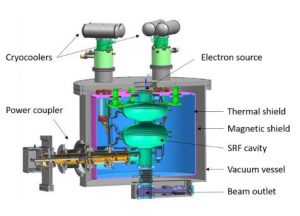Additive metal manufacturing (AM) is a rapidly growing industry. Key drivers for AM include high-value parts, tooling and one-offs such as aerospace, turbine blades. The size of components and the speed with which components can be built is limited by the beam power of the electron beam melting (EBM) machine. Thus, an increase in beam power with excellent energy efficiency will be an attractive option for EBM machines.
Current machines use DC technology that max out at 3,000 watts of beam power. A 1.5-cell variant of the Compact SRF Accelerator can provide 50,000 watts of beam power. The Compact SRF Accelerator will allow energy efficient e-beam machines that can build components 15 times larger (or, alternatively, build components 15 times faster compared to the leading product on the market).
The ability to print production quality parts faster, larger, at a higher quality and across a wider range of materials is essential to widely adopting additive manufacturing of metals. Fermilab-patented high-power, high-energy compact electron beam technology shows promise to unleash additive production by enabling fast, high-quality printing of high-value, high-performance metals. Doing so can unlock the national vision for a customizable, decentralized, on-demand production capability that reshores American manufacturing and ensures the security and resilience of the defense, aerospace, medical device and other high-value manufacturing industries.
Refractory metals such as tungsten, tantalum and niobium hold significant manufacturing value in industries from energy to aerospace. The same properties that allow refractory metals to perform under the harshest conditions create significant barriers to additive fabrication. High-energy and high-powered e-beam technology holds the promise to overcome these obstacles.


